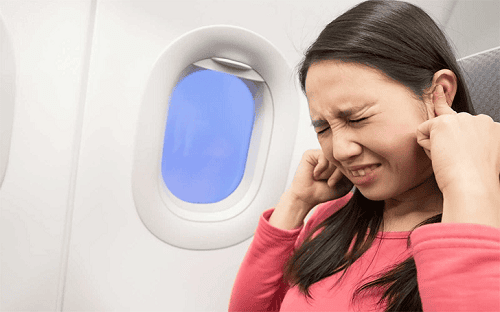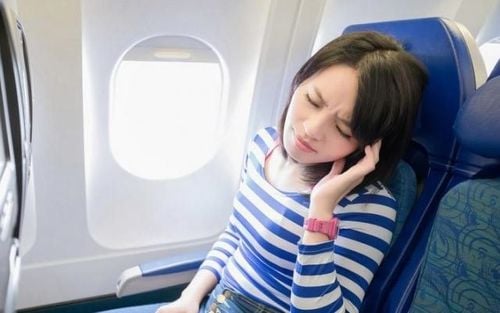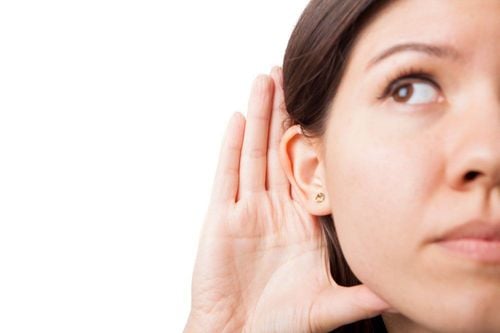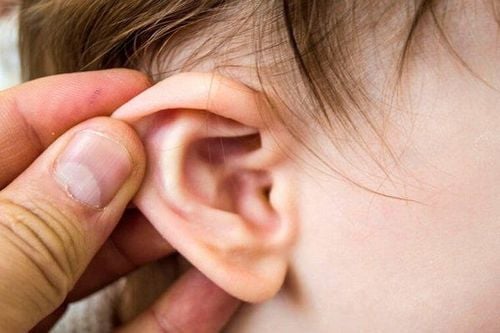This is an automatically translated article.
Tinnitus during take-off and landing (also known as tinnitus when traveling on an airplane, ear pain when traveling on an airplane, barotracheal damage, barotracheal otitis) is a condition in which the eardrum is subjected to pressure when the eardrum is pressurized. Pressure in the middle ear and in the environment are not equal, this phenomenon most often occurs during take-off or landing.1. Symptoms of tinnitus when traveling by plane
Often simple individual actions such as yawning, swallowing or chewing gum can rebalance the pressure difference and improve the symptoms of tinnitus when flying. However, there are still cases of severe tinnitus that need to see a doctor.Tinnitus when flying can occur in one or both ears. Common signs and symptoms include:
Moderate discomfort or pain in the ear. A feeling of fullness or stuffiness in the ear. Tinnitus, mild to moderate hearing loss. If the flying tinnitus is severe, the symptoms could be:
Severe pain. Increased ear pressure. Moderate to severe hearing loss. There is noise in the ear. Feeling dizzy. Ear bleeding. If discomfort, fullness or tinnitus persists for several days, or if signs and symptoms are severe, see a specialist.
2. Causes of tinnitus when traveling by plane

Ù tai khi đi máy bay xảy ra khi áp suất ở tai giữa và áp suất môi trường không cân bằng nhau, khiến màng nhĩ rung động không bình thường
In the ear there is a part of the eustachian tube (connected to the middle ear) that is responsible for regulating and equalizing pressure. But when the plane takes off and lands, the air pressure changes so quickly, the eustachian tube often does not respond in time, causing the symptoms of tinnitus when flying. The act of swallowing or yawning causes the eustachian tube to widen, allowing more air to enter the middle ear, equalizing the pressure.
Barotrauma to the ear can also occur when:
Scuba diving. High pressure oxygen room. There is an explosion happening nearby, such as in a war zone. Some cases of ear barotrauma, although rare, can still be encountered, such as when riding an elevator in a high-rise building.
3. Risk factors for tinnitus when flying
Any condition that blocks the eustachian tube or limits its function can increase your risk of developing tinnitus when flying. Commonly seen risk factors include:Small eustachian tubes, especially in young children. Cold. Infectious sinusitis. Hay fever (allergic rhinitis). Middle ear infection (infective otitis media). Sleep during takeoff or landing (can't yawn or swallow to equalize pressure).
4. Complications of tinnitus when traveling by plane
Tinnitus when flying is a normal phenomenon, not serious, individuals can overcome the situation on their own. Long-term complications are rare, only when the condition is severe, persistent, or there is physical damage to the structures of the middle or inner ear.Rare complications may include:
Permanent hearing loss. Chronic tinnitus.
5. Preventing tinnitus when traveling by plane

Ngáp và nuốt trong khi máy bay cất cánh và hạ cánh để tránh ù tai
Yawning and swallowing during takeoff and landing: these actions act on the muscles that cause the eustachian tube to open. If you have trouble swallowing, sucking on candy or chewing gum can help. Use the Valsalva maneuver during take-off and landing: close your mouth, close your nostrils with your hands, and slowly exhale air through your nose. Repeat several times, especially during landing, to equalize the pressure between the ears and the cabin. Avoid sleeping during take-off and landing: do not sleep during take-off and landing so that actions can be taken to rebalance the pressure when you start to feel symptoms. Rethink your travel plans: If possible, don't fly with a cold, a sinus infection, a stuffy nose, or an ear infection. If you've had recent ear surgery, talk to your doctor about when it's safe to fly. Use over-the-counter nasal sprays: if you have a stuffy nose, you can use over-the-counter nasal sprays 30 minutes to 1 hour before takeoff and landing. Avoid using too much because if used 3 to 4 days will make the stuffy nose increase. Caution when using oral decongestants: using an oral decongestant 30 minutes to 1 hour before departure may be helpful; However, people with heart disease, arrhythmia, high blood pressure, pregnant or young children should not drink. Try using earplugs: the earplugs slowly equalize the pressure on the eardrum during take-off and landing, but even with the use of earplugs, you still have to yawn and swallow to relieve the pressure. .
6. Diagnosing tinnitus when flying

Có thể sử dụng thuốc để giảm tình trạng ù tai khi đi máy bay
For most people, the tinnitus when flying will go away on its own. If symptoms persist, treatment will be needed to rebalance the pressure and relieve symptoms.
6. 1 Medicine The doctor may prescribe:
Nasal spray containing decongestant. Oral medication containing decongestant. To relieve discomfort, non-steroidal anti-inflammatory drugs such as ibuprofen, naproxen sodium or pain relievers such as acetaminophen can be used.
6.2 Self-care Therapy Along with medication, the doctor will instruct the patient to perform the Valsalva maneuver.
6.3 Surgery Usually surgery is not needed, and it is extremely rare that surgical assistance is needed.
Please dial HOTLINE for more information or register for an appointment HERE. Download MyVinmec app to make appointments faster and to manage your bookings easily.
Article referenced source: mayoclinic.org












